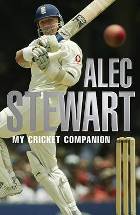My Cricket Companion
Martin Chandler |Published: 2009
Pages: 303
Author: Stewart, Alec
Publisher: Corinthian Books
Rating: 2.5 stars

During his long England Test career Alec Stewart was, deservedly, a popular man. His approach to the game was a simple one. If the ball was there to be hit it got hit and it didn’t matter if he was opening the batting or in the lower middle order. I must confess to having read very few of his columns in the Daily Mirror but from what he says on television and radio he seems to have carried that philosophy through into the media work he has done since his retirement.
My Cricket Companion is Stewart’s first book since his 2003 autobiography. I am afraid it is a rather disorganized book and something of a curate’s egg. It begins with a series of short writings about Stewart’s views on the game interspersed with, often, unrelated statistics, trivia and historical digressions. The robust and uncomplicated nature of Stewart’s opinions will come as no surprise to those who are familiar with the man. Typical of them are his attitude to “walking” – he didn’t and he repeats the same justifications for that as those who take the same view invariably do.
The statistics and records that are set out are not particularly illuminating and it is difficult to avoid the suspicion that they are there as much as anything to fill up space. The passages of trivia and historical information rarely examine the incidents they raise in very much detail.
The second part of the book is vulnerable to similar criticism, although that at least has a coherent purpose and, it has to be said, an original and interesting one. What Stewart does is to take each number from one to one hundred and choose a Test match innings where it was scored and tell the story. As is only to be expected most are chosen from well known matches but that is not always the case and some potentially very interesting tales are touched upon usually, unfortunately, with rather less explanation than the reader would like. A good example is 16, scored in the fourth innings by Anil Dalpat, the first Hindu to play for Pakistan, against England in Karachi in 1984. The innings was the major contribution to the home side, after losing five quick wickets, getting to a small victory target to record their first ever Test victory against England on home soil. After unearthing such a little known gem, and one so ripe with possibilities for a detailed examination, it is a great disappointment that it is then dealt with in just three sentences.
It is easy to be harsh on this book if, like this reviewer, the reader has a reasonably thorough knowledge of the game and its rich past, and it is certainly not recommended for the historian. That said if this book fell into the hands of a recent convert to the game it would certainly give a taste of the delights in store for them if they decided to pursue their interest in cricket beyond the here and now. With Christmas not too far away and, seemingly, the book having now been remaindered, My Cricket Companion would be an ideal present for a youngster just getting to grips with the game. With this in mind it is not entirely straightforward to attribute a rating so I have decided to use an average and have come up with 2.5 stars. That is based on just 1 star for the likes of Archie Mac, but 4 stars for his cricket mad 13 year old nephew.







Leave a comment